Structure of a 90min Reading Block for Teachers
Fitting It All In: How to Schedule Your Literacy Block for First Grade
- May 30, 2015
**Looking for Kindergarten literacy block schedules? Click HERE. Or for 2nd grade literacy block schedules, click Hither.**
In this post, I'll take you through the components of a literacy cake for first grade. I'll as well provide some sample schedules and share full general scheduling tips!
Earlier I get started, I exercise want to say that in that location'southward no i "correct" fashion to set upwards your literacy block. The best schedule is the one that meets the needs of you and your students. Also, I love hearing other teachers' creative scheduling ideas, then please practice comment at the cease of the article!
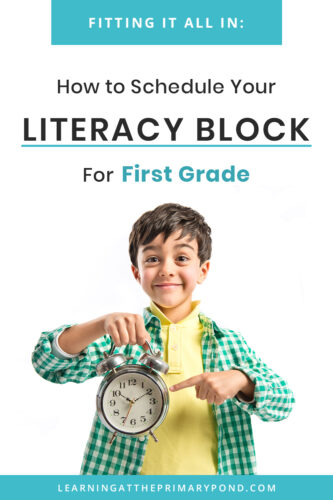
Components of a Literacy Block for Commencement Grade
While literacy can and should be a part of every component of your day (even math!), hither are the building blocks that I used to schedule my first grade literacy instruction:
- Readaloud
- Shared Reading (+ reading workshop minilesson; can be combined)
- Guided Reading / Minor Group Literacy Piece of work with Phonics + Literacy Centers
- Independent Reading
- Writing Workshop Minilesson (may include modeled/shared writing and interactive writing)
- Independent Writing
- Word Work / Phonics
- Phonological Awareness
Readaloud (10-15 minutes):If at all possible, I actually do a readaloud twice a 24-hour interval (some years I definitely can't brand this happen, though). During one readaloud, we read for enjoyment and understanding. At a dissimilar time of the day, we read a book to focus on comprehension strategies and vocabulary. If you can do two readalouds a day, you might want to focus on comprehension and vocabulary during a literacy block readaloud. Then, you could practise another readaloud for enjoyment after tiffin or recess. Yous don't necessarily need 2 make new books for each 24-hour interval, all the same. For example, you could read aloud a volume for enjoyment on Monday later lunch. Then, you dive into that same volume more deeply on Tuesday during your literacy block. This is how I accept my Reading Comprehension Units for K-1 set up. When you lot teach one of the comprehension minilessons, you often use a book that you've previously read aloud to students. This is because I've establish that kids can better focus on practicing comprehension strategies when they've already listened to the book. If you don't take fourth dimension for two readalouds in a day, you might focus on comprehension Monday, Wednesday, and Fri, and read for enjoyment on Tuesday and Thursday.
Shared Reading (10-20 minutes): This is when I read aloud (and take students help me read) a big book, poesy on chart paper, or a story from the basal reading series. If students practise not all have copies of the text, they sit down on the rug and then that they can easily see the print. We typically read only two stories per week during shared reading. This is because we read each text multiple times (offset time for comprehension and enjoyment, and additional times for teaching points like "Look for a clamper of the give-and-take that you lot know"). Shared reading can be used to teach decoding, fluency, vocabulary, and comprehension strategies.
Guided Reading / Small Grouping and Centers (45 minutes):During this block of fourth dimension, I run across with students for guided reading while the other students work independently. In guided reading, I provide students with scaffolding so that they can read texts at their instructional level (slightly harder than what they could read independently). The students who are non meeting with me piece of work in literacy centers. (Note: your small group reading didactics does Not ever need to be guided reading! In that location's also value in meeting with a grouping of kids to work on a reading strategy, or to support them in reading grade-level, rather than instructional-level, text.)
Reading Workshop Minilesson (10 minutes):I teach a decoding, fluency, or comprehension skill (merely one per lesson) that students tin can exercise as they read independently. This is a very brief, focused lesson and can hands be combined with shared reading.
Independent Reading (25 minutes +5 for sharing time): Students read independently (not silently, merely whisper reading). Yous can also contain contained reading time into your literacy centers, but I've institute that kids are more than focused when the classroom is placidity and anybody is focused on independent reading at the same time. I confer with kids individually while everyone is reading. After contained reading time, we come up dorsum together every bit a group then the kids can share about their reading and strategy use with a partner or the form.
Writing Workshop Minilesson (10 minutes):I teach a brief, focused lesson on a writing skill that students can use in their own writing. I structure my writing units by genre, so whatever skill I'thousand teaching is related to that genre. I model existent writing during nigh every one of these minilessons.
Independent Writing (25 minutes + 5 for sharing time): Students write independently, and I confer with kids individually. After independent writing time, we come back together every bit a group so students can share their writing with a partner or the form.
Phonics / Word Work (10-20 minutes, plus more in pocket-sized groups): I teach From Sounds to Spelling or another phonics program in a small grouping setting. I typically meet with 1-two groups per day to introduce a phonics/spelling pattern. At the same time, other students are working independently with their assigned words. It takes some time to set, but differentiating discussion study has been super constructive with my kids in the past.
Phonological Awareness (v minutes spread out throughout the day): This is when we practice quick, oral activities to increase students' awareness of the sounds in words. Phonological awareness activities can include rhyming practice, segmenting words into their private sounds (cat -> /c/ /a/ /t/), blending private sounds to make words, substituting sounds, clapping syllables, etc. I don't ordinarily write phonological awareness into my daily schedule because we do these activities during transition times.
Sample Schedules for a First Grade Classroom
So what does this look like in a first form classroom? Below are some schedules that I and/or my colleagues take used in the past. I included some variation in the amount of fourth dimension yous spend on each activity, the number of specials classes you lot have, and length of the school 24-hour interval.
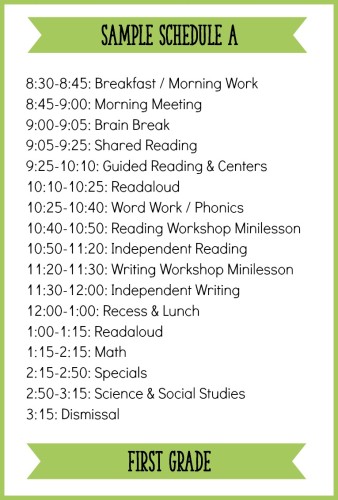
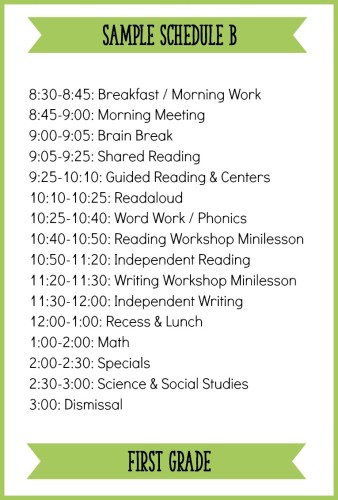
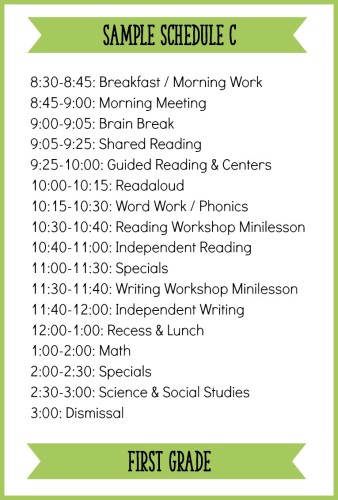
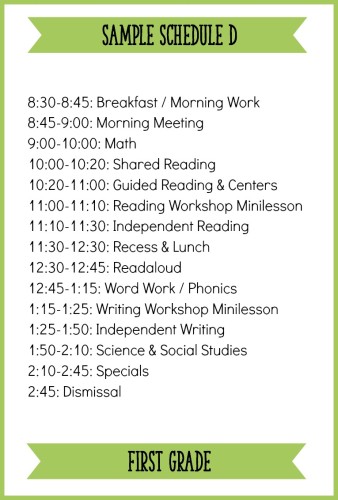
Even though I generally followed i of these schedules, our day in kickoff grade didn't ever look like this throughout the entire twelvemonth. I honey to teach integrated thematic units that engage kids in learning content surface area material through literacy activities (i.east. reading about and writing about animal habitats). At the outset of the year, it's bang-up to establish a routine that provides kids with consistency. But as the year goes on, I call up information technology'south completely fine (and sometimes necessary) to deviate from that schedule. Literacy learning doesn't ever fit nicely and neatly into a box!
General Scheduling Tips
Ideally, you lot could choose one of the above schedules, arrange information technology slightly, and go with it. However, I know from experience that it's not always that easy! If you can't use any of these schedules and have to write one from scratch, here are some general tips that I keep in mind when doing my scheduling:
- When y'all write your schedule at the beginning of the yr, make 2 schedules: 1 for now and one for after. When our offset graders come up to us at the starting time of the year, they are still babies! I try to continue "sitting and listening activities" brief, and I carve up silent reading fourth dimension up into 2 5-10 infinitesimal chunks. I make sure to create a starting time-of-the-year schedule that reflects their developmental needs, simply I also create an end-of-the-twelvemonth schedule, also. Keeping that end-of-the-year schedule handy helps me gradually transition my students to where I need them to be.
- Programme to teach the most important skills right at the outset of the twenty-four hour period. Students are most focused at this time and are more than likely to retain what you teach.
- Alternating activities that involve sitting quietly/listening with activities that involve movement.For instance, you might teach a minilesson, take students piece of work in centers, and and so read a story aloud. If you must have two "sitting and listening" activities back-to-back, make sure to include a movement suspension in between them.
- Prioritize educatee practise time. When I accept limited time, I tend to want to fill it with instruction, to squeeze in every possible lesson I can. But what kids really need is time to do with your support. I try to distill my lessons and then that they are brusk and to-the-point, and then requite students as much time to exercise as possible.
- Begin and end the day every bit a group. It builds customs for students to come together for morning coming together or an end of the day routine. These are definitely my favorite times of the day!
I hope this postal service gave you some ideas for structuring your literacy block! If y'all are looking for reading and writing curriculum for kickoff grade, click on the images beneath to read more.
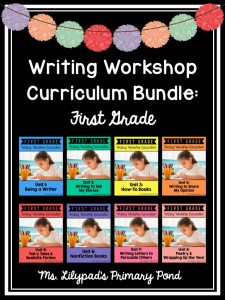
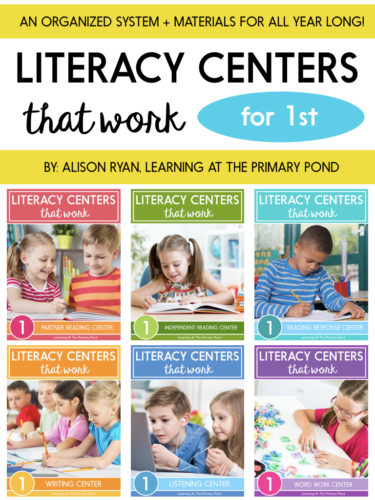
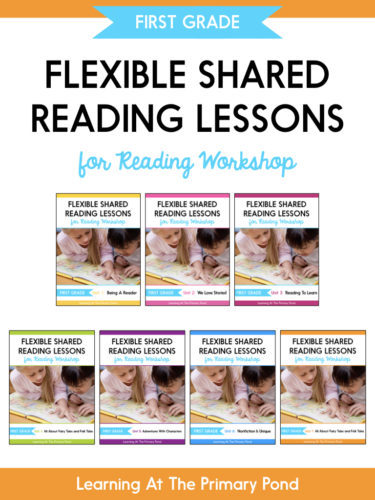
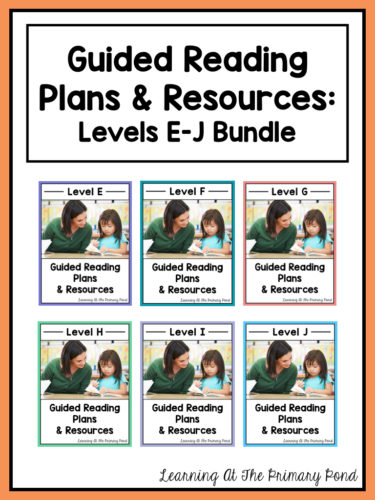
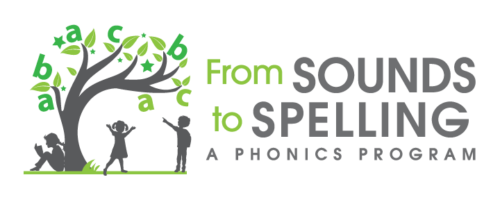
Happy teaching!
Related Posts:
Alison
Welcome!

I'yard Alison, a literacy specialist. I love getting kids excited about reading and writing – and sharing instruction ideas with other teachers!
Detect It fast

Source: https://learningattheprimarypond.com/blog/balanced-literacy-block-for-first-grade/
Inline Feedbacks
View all comments
Hullo Alison 🙂 – you have a fantastic proper noun!
I Love your writing resource that was posted on FB, I am just moving into first afterward a brief 2 twelvemonth stint in 4th & 5th. I had taught K before, just first is a new adventure.
Cheers for posting such great stuff! I'd honey for you to visit my blog, if you'd like! At that place isn't much there nevertheless – I only started over!
Have a fantastic day,
Alison 🙂
Thanks for your comment!! I love meeting one "L" Alisons, haha. 🙂 Proficient luck in first!! They are and so beautiful and brand then much growth – I bet yous will really enjoy it. And your blog looks great!!
Alison
Kimberly Burkeen
6 years agone
Do you lot teach Common Core standards?
Hi Kimberly, yes I exercise! I live in Illinois, which has adopted the Common Core. 🙂 Alison
Swell article! I wish we had this much time for ELAR…we simply have 2 hours MAX!!! ?
Hi Kelly! I know a lot of other teachers have the same result. It's so challenging fitting everything in! Thanks for reading 🙂 Alison
Howdy,
Is your literacy time interrupted? Pregnant are all of your students present for all instruction? The various schedules you provided were very helpful!
Hello Jen! I've taught in several different schools, and it just depended upon the school. For the most part, it was not interrupted. Are your students leaving for intervention or ESL?
Alison
Tin y'all tell a little bit about what activities you take your kids do during workshop, when yous run across with groups!?
Hi Dani! Do y'all mean reading workshop? I've done it many different ways. My favorite is to have all kids reading at the same time, so I may or may non exist meeting with groups then (I sometimes do private conferences instead). But if I'm doing centers, I like to do discussion sorts, partner reading, having kids reply to texts in writing, sight word practice, and things like that. I'll write a post in the next few months to get more in depth on centers. 🙂
Alison
MICHELLE VANALST
5 years ago
I beloved your counterbalanced literacy schedule. Yous are amazing. I have one question what do you lot use for science and social studies. Our reading trainer wants u.s. to contain science and social studies into our read alouds and shared readings. We currently have a carve up time for it similar you do in your sample schedules above. Can yous give me some suggestions of what y'all do. Thank you!
Hi Michelle! I love incorporating science and social studies into read alouds and shared reading. I still like to take a split up fourth dimension for the content areas though (though information technology doesn't demand to be as long if I'm integrating into the literacy block). During that separate time, we tin can revisit the text – considering frequently, during read alouds or shared reading, nosotros are focusing on a strategy, as well. The actress science and SS block is a gamble to dig deeper in the content of the text. We watch videos on the topic, practise experiments, and other activities that wouldn't fit … Read more »
Hi Alison! I dearest you post! I agree with EVERYTHING you have said here and that is why it is mid October and I am Yet struggling to gear up a daily schedule in my classroom. My struggle had me looking at as many sample schedules as I could detect and that'south when I happened on your post. I was wondering if you could tell me how you would handle my schedule? We kickoff at viii:45 with the pledge and announcements usually washed by eight:55. I accept related arts from ten:25-11:10 and lunch from eleven:25-11:55. Then from 12:30-i:xxx nosotros accept Power … Read more »
Hey Emily! Then distressing to hear you are having trouble with your schedule! I'thou planning a longer mail on this topic (trying to fit everything into your literacy block when you accept limited time) for December third. Merely in the meantime, here are some ideas: – Are there any areas where yous could alternate days with an A Day/B Day schedule? Example: Spend more fourth dimension on word study ane twenty-four hours and more time on writing another day? I've found that trying to exercise fewer things for longer chunks of time helps a bit! – Could you combine certain components of … Read more than »
This post is super helpful! I'yard a showtime year teacher, and I'm spending my year pedagogy Offset Grade in a bilingual schoolhouse in Nicaragua. Every 24-hour interval I have the outset xc minutes for Language Arts with my kids, just then I merely take 45 minutes for math and 45 for scientific discipline (science is iii days a week) that are spread throughout the rest of the solar day. The kids have Spanish, ESL, and a special too that are taught past other teachers. I don't have much fourth dimension with my kids and I've been struggling to brand the most of the … Read more »
How practise y'all squeeeeezzze it all into a lesson plan book with 7 columns? Help!!!
Hi! Are you required to employ a plan book? I actually haven't used 1 in near nine years! I dear using something like Google Drive to make my plans!
Alison
Kimberly Hermann
four years ago
I noticed that yous don't accept fourth dimension scheduled for class bathroom breaks, do you not take form bathroom breaks? If not, how do you lot manage the revolving door of kiddos that have to become to the restroom throughout lessons? Besides, we accept to provide handwriting instructin (correct letter germination, etc.). Do you provide that daily instruction? I'm really struggling trying to fit everything in…any advice y'all can give would be appreciated.:)
Hey Kimberly! Correct, I usually let my kids get as they need to (and encourage transition time or other times other than lessons). I do have similar a fiddling snack break (non sure if I put it in there) when they are also encouraged to go. Some years I've had the restroom right in my classroom or correct across from my classroom, though, which makes it easier. I don't do handwriting education on a daily footing – we tend to exercise information technology more at the beginning of the year and so here and at that place every bit time permits. It IS difficult … Read more than »
This mail service was very helpful!! We're recently trying to implement something similar in our school and I've felt a little lost. This really helped me so much!! I am nonetheless struggling though because nosotros only become 120 minutes of reading time. Is there any advice yous have for adjusting the schedules from around 3 hours to 2?
Hello, I stumbled beyond your blog while I was aimlessly researching balanced literacy and I am thrilled! I noticed in your post that you have shared reading, read aloud, and a reading mini lesson listed separately. Can you lot explain how they are different? Should they all be over the same skill/strategy, or connected in some mode? Thanks for helping out this frazzled, first year first class teacher!
Hey Amanda! I'm then glad this is helpful! I consider shared reading to exist an opportunity for yous to piece of work with the kiddos using a text you ca both see. It might involve modeling and educatee participation. In a readaloud, you lot're doing all of the reading work and usually reading them a book that they could non read on their own (this presents opportunities for vocabulary instruction, discussing more circuitous ideas, etc.). A minilesson typically has a focused teaching point and may use function of a text as an example, only non an entire text – i.e., yous're teaching students … Read more »
Looking over your schedule and trying to adjust it to 120 minutes including a 35 infinitesimal reading cake. Like your idea of a and b schedules to get everything in and the manner y'all di read alouds. Give thanks you for sharing.
Lauren Pollak
3 years ago
Thanks for this post – information technology was very interesting and includes some groovy ideas and suggestions. Quick question about your sample schedules…..do y'all really not have a snack and recess interruption during the morning block? And how on earth do you manage to fit all of science and social studies into a 20 minute block at the end of the day?? Given that at my schoolhouse we accept just a fraction of the time for ELA that y'all do, I'm wondering what parts you'd advise cutting back on first. I've got almost 90 min/day to try to fit in a … Read more than »
Hey Lauren! During the morning, no, I've really never been at a schoolhouse that had a recess pause and then! Nosotros have had a snack break, where I usually let the kids socialize for a few minutes or read aloud to them equally they ate. Science and social studies has dedicated pedagogy in that twenty minute block, but I really like to address the concepts during the literacy cake, besides. So we might be reading books and writing most those topics throughout the day, even if just that certain block is dedicated to it. This mail might be helpful to you … Read more than »
Alison,
Thank you for all the great work you lot have done! Your resources are practical and helpful!
Question: Do yous have or are yous planning to create a RW units/packet for commencement grade?
Alison, what are your thoughts on calendar?
Hey Colleen! I similar to do some kind of calendar activities in first class – a great way to integrate math skills. I think it's like shooting fish in a barrel to let the routine become Likewise routine, though, and no purposeful. So we don't necessarily do the same agenda activities every day (or at to the lowest degree we switch periodically). I usually permit the kids take turns leading calendar time, besides!
Alison
Lesli Bartlett-Roker
2 years agone
Thanks Alison…where can I notice my document for completion of course? Thanks
Hi Lesli! Please email me if you're missing a webinar certificate. 🙂
Alison
Hi Allison,
I take six literacy groups this year. I still accept your five group plan, but what would your 6 group plan expect like? I only take ane group that is reading below grade level.
Hey Susan! I don't recollect I've had half-dozen groups before – merely what I would recommend is mapping it out so that your low groups sees you a bit more than oftentimes, if possible. It will likewise depend on how many groups yous see per day!
Alison
Hello! Excellent site hither.
I'm curious well-nigh your example schedules. I only see one slot for centers in each. I believe several of your activities are done in pocket-sized group. Can y'all analyze which activities you exercise in small group while others are at stations?
Thanks
Hi Giselle! I practice some guided reading, strategy work, and phonics work in small groups. 🙂
Alison
where practise vocab words fit in to this schedule?
Hey Sarah! I've addressed vocabulary at dissimilar times of the day. Correct at present, my school is using a program where read-alouds and vocabulary are washed together. So the read-aloud / comprehension piece of work time would be extended because sometimes there is vocabulary work in there.